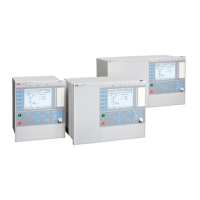impedance. For this reason it is necessary to enable the logic by connecting the PUPSD
input signal to some other functional signal, which is used for testing purposes.
Make sure that the existing configuration permits monitoring of the CS, TRIP signals on
the binary outputs of the IED. If not, configure connections to unused binary outputs, for
test purposes.
11.4.10.1 Testing the carrier send and trip signals
Procedure
1. Set the operation of all distance zones, which are supposed to be blocked by the
operation of ZMRPSB (78), to Disabled.
2. Configure the PUPSD functional inputs to the TRIP output of the underreaching
power-swing zone, if the underreaching communication scheme is used.
3. Start instantaneously any kind of fault within the underreaching power-swing zone
and check, that:
• The CS signal appears after the time delay, which is equal to the sum of set time
delays for the underreaching zone tnPP or tnPG (dependent on the type of
fault) and for the carrier send security timer tCS. Also add the usual trip time
for the underreaching zone (approximately 30ms).
• The TRIP signal appears after the time delay, which is equal to the sum of set
time delays for the underreaching zone tnPP or tnPG (dependent on the type
of fault) and for the trip security timer tTrip. Also add the usual operate time
for the underreaching zone (approximately 30ms).
4. Simulate the receiving of the carrier signal so that the functional input signal CR
becomes a logical one.
5. Configure the PUPSD input to connect to the output PICKUP of the carrier
accelerating zone (Power-swing overreaching zone).
6. Initiate any kind of fault within the carrier accelerating zone and check that the TRIP
signal appears after the time, which is equal to the time delay set on the trip timer
tTrip.
Also consider the (average) trip time of the carrier acceleration zone (approximately
30ms).
11.4.10.2 Testing the influence of the residual overcurrent protection
Additionally connect the IED according to the test instructions for the four step residual
overcurrent protection function EF4PTOC (51N/67N), if the Power swing logic
(PSLPSCH) is configured in a way that is controlled by this protection.
Procedure
Section 11 1MRK 504 165-UUS -
Testing functionality by secondary injection
146 Transformer protection RET670 2.2 ANSI
Commissioning manual

